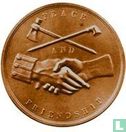

Enlarge image
USA George Washington - Peace & Friendship Medal 1789


Catalogue information
LastDodo number
4735769
Area
Tokens / Medals
Title
USA George Washington - Peace & Friendship Medal 1789
Publisher
Value
Country
Year
1801
Collection / set
Material
Weight
Variety / overstrike
Obverse
GEORGE WASHINGTON PRESIDENT OF THE UNITED STATES 1789
Reverse
PEACE AND FRIENDSHIP
Privy mark
Mint mark
Engraver
Dimensions / Diameter
76
Number
Details
Mass: 228 grams
Following the practice established by European powers in the American colonies, U.S. presidents and their agents gave these medals to the chiefs or significant warriors of Native American tribes as tokens of friendship, sometimes accompanied by explanations of newly established U.S. sovereignty. The best known examples were the medals carried by Lewis and Clark on their 1804-1806 expedition to explore the Louisiana Purchase. Those were made of silver, of three different sizes. They were the first American Indian peace medals to be struck as opposed to engraved, but they were struck on two thin sheets of silver and held together by an outer band. Prior to James Madison's time, the obverse and reverse were separate silver sheets. The exact origin of Indian Peace Medal distribution is obscure. "Indian Peace Medals" were often typically accompanied by a token of a flag of the colonial power conducting diplomatic negotiations with the tribe.
Red Jacket from an 1835 lithograph by Henry Corbould, after a painting by Charles Bird King, printed by Charles Joseph Hullmandel. Published in History of the Indian Tribes of North America.
From 1801 onwards, the reverse of an Indian Peace Medal depicted clasped hands and a crossed tomahawk and ceremonial pipe. It also included the phrase Peace and Friendship. The left wrist was covered with the ornamented cuff of a military uniform; the right wrist was bare, except in the case of Jefferson's medal, which covered the wrist with a broad metallic bracelet with the image of an eagle on it. The Jefferson design is also the basis for the reverse design of some 2004 nickels.



